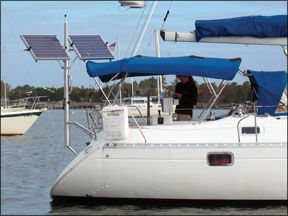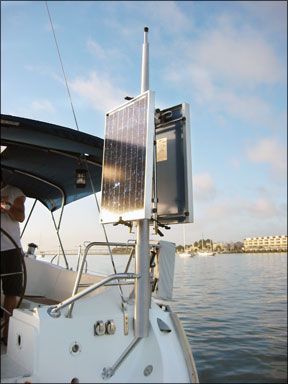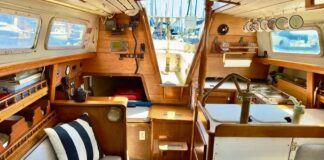Solar panels have proven themselves a valuable ally in the never-ending battle to keep batteries charged and todays power-hungry systems fed. A common sight aboard world cruising sailboats and weekend warriors alike, solar panels have many pros backing them up: Theyre noiseless, have no moving parts, and provide free electricity for years with minimal maintenance, all without producing harmful emissions or using up valuable natural resources.

Despite all the benefits, solar panels have issues other than their high purchase price. Their mounting location must not eat up limited cockpit or deck space (an issue in all but the smallest installations); they require adequate air flow to avoid heat buildup (which can seriously reduce power output); and they reach optimal output only when facing the sun, a limiting proposition for fixed-mount installations.
The folks at Solar Stik http://www.solarstik.com/ have come up with a product that addresses each of these issues, and then some. The Solar Stik is a unique system that combines existing technologies to overcome the problems listed above. The result: A solar-power system that, in many regards, is greater than the sum of its parts.
The Solar Stik consists of two 50-watt BP350U multi-crystalline solar panels mounted on a tapered aluminum pole. The assembly rotates 360 degrees at its base and locks into any position, while the panels fold up and down and rotate along the horizontal axis, providing full panel articulation. Also included with each complete system is a Blue Sky Energy Solar Boost 2000E MPPT (maximum power point tracking) charge controller, which pumps up the output potential of the solar panels. Practical Sailor profiled this revolutionary technology last year (“Boosting Solar Output with Blue Sky,” August 2006).
CONSTRUCTION / MOUNTING
The Solar Stik is robust and well made. (All materials are either 304/316 stainless steel or T6061/T5052 aluminum.) The Solar Stik can be purchased as a transom- or deck-mounted unit. The transom-mount system ($3,850) is essentially a “bolt-on” unit. However, its location can preclude the use a steering vane. According to the manufacturer, the transom mount takes about three to four hours to install, while the deck-mount system ($3,425) is a more involved installation typically requiring fiberglass work and/or welding.
In addition to freeing up deck space when mounted, the Solar Stik also serves double duty as a mount for other equipment. It can accommodate a smaller wind generator (such as the Rutland 913 or Ampair 100), VHF or GPS antennas, a radar dome, etc. Its also strong enough to support a small lifting davit.
The Solar Stik is lightweight (80 pounds, per the manufacturer) and when broken down, no single piece weighs more than 20 pounds. Panels can be deployed or secured in the down position for passagemaking or easily removed and stowed for storms or to prevent theft.
OUTPUT
As mentioned previously, all solar panels will produce more power when cool and facing the sun (the closer to 90 degrees, the better). Traditional horizontal-mounted solar panels generally reach maximum production between 10 a.m. and 2 p.m. Power output will ramp and decline on either side of this period, with maximum power being achieved only if the sun actually passes directly overhead. Deck-mounted panels also suffer from excessive heat build-up, as most are mounted with little or no clearance between the panel and the deck, resulting in poor air circulation.

Single-axis mounts found on railings or davits help address cooling issues and allow some flexibility when adjusting the panels, but the actual sun-to-panel face-time they provide is dependant on sun and vessel orientation relative to that single axis. The three axis of rotation the Solar Stik allows full-panel articulation, meaning panels can be adjusted for maximum exposure throughout the day, no matter what the boats position is relative to the sun. Additionally, the high wing-like arms of the mount provide excellent airflow around the panel, lowering panel temperature and aiding power output.
CLAIMS AND RESULTS
A myriad of factors affecting solar panel output&emdash;cloud cover, geographical location, season, hours of daylight, etc. That being said, the manufacturer claims that by combining full panel articulation (with three adjustments throughout the day), increased airflow, and a Solar Boost 2000E, output for the Solar Stik should be roughly 70 to 80 amp hours per day in optimal conditions. Weve been able to achieve 80 to 90 Ah in the Mediteranean with two 80-watt panels on single-axis mounts, MPPT boosting, with the panels adjusted six times per day.
In March, we set up a Solar Stik at a test site on the Chesapeake Bay. We tested the Terra version, which has the same pole and panels used in the marine version, a tripod mounting system, and a Power Pak 100 (a portable power unit containing a Solar Boost 2000E and a 100 amp-hour reserve AGM battery bank). A Xantrex XBM Battery Monitor was installed to measure both cumulative and real-time amp hours generated. (See table, this page.)
We began taking preliminary readings at 9 a.m., followed by a cumulative amp-hour test from 10 a.m. to 2 p.m. Panels were adjusted hourly for maximum output (according to the Solar Boost and Xantrex gauges). Spot panel outputs were recorded both with and without use of the Solar Boost. We also noted output with a single quarter-inch line draped across one panel (as an example to show how power output can be reduced by shadows, even a thin one the size of a rigging wire). Weather-wise, skies were sunny and clear from 9 a.m. to 12:30 p.m., with partly cloudy conditions thereafter until the conclusion of the test at 2 p.m.
CONCLUSION
Based on our experience with the Solar Stik, the manufacturers claim of 70 to 80 amp hours per day in optimal conditions is reasonable, but “optimal” is the operative word. Add a wind generator, and you have a good shot at meeting a 100Ah daily requirement.
Practical Sailor does believe that one can match or beat the output at less cost. (We priced two 80-watt solar panels, plus Solar Boost at less than $1,600, leaving $1,800 for wiring and a custom mount.) However, the solution would be less compact, less elegant, and probably require more effort. To match the level of quality would entail some expensive custom work. In either case, the cost of the mounting system would be offset if the mount served multiple purposes&emdash;radar, dinghy engine hoist, wind generator mount, etc. We will be gathering cumulative output figures in a future test of the Solar Stik. Also on the horizon is a comparison of solar panels.






































